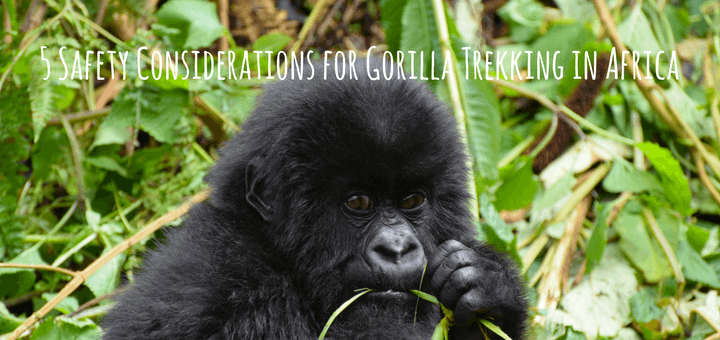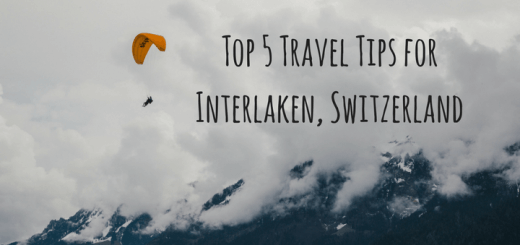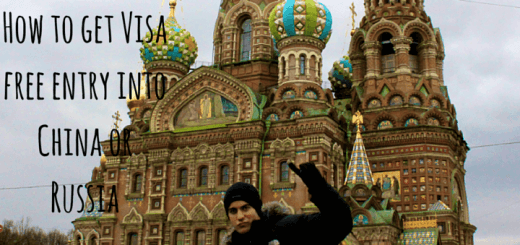5 Safety Considerations for Gorilla Trekking in Africa

In view of protection, mountain Gorilla tourism in Africa is a tightly regulated conservation project and is also the main tourism draw for all the 3 mountain gorilla countries; Uganda, Rwanda and the Democratic Republic of Congo.
A number of safety precautions have been set and strictly followed so as to ensure the security of visitors who come to Africa to fulfil a bucket list adventure of gorilla tracking in the jungle as well as mountain gorillas protection and safety in their natural habitat which is managed with a set of rules which trekkers must, in turn, follow while with the gorillas.
In the 1980’s mountain gorillas in Africa were at a brink of extinction due to uncontrolled human activities like poaching, lack of government concern, diseases from humans, civil wars which were rapidly reducing the number of mountain gorillas.
This caught the attention of Dian Fossey, who built a Karisoke Research Center along the slope of mount Karisimbi on the Rwandan side of the Virunga conservation region and dedicated her life to saving the highly rare endangered primate species whose numbers had gone less than 300 individuals across the Virunga massif region which covers borders of Uganda – Mgahinga national park, Rwanda – Volcanoes national park and Congo – Virunga national park.
With the conservation efforts of Dian Fossey, gorilla tourism became the only feasible way to protect and save mountain gorillas from extinction as income from gorilla permits sales finance conservation project including supporting research, paying gorilla doctors, medicines, park staff as well as benefiting the governments where gorillas are located.
Local communities neighbouring the parks have also immensely benefited from gorilla trekking as a percentage of gorilla permit income is directly offered for communal development projects and former poachers have become gorilla guardians, porters and park rangers passionately guiding tourists through the jungle searching for gorillas.
Today mountain gorilla tourism has become an ultimate adventure with thousands of tourists travelling to Africa to take part in guided gorilla safaris deep in the jungle rainforest to see mountain gorillas in their natural habitat.
Tours to see gorillas in the jungle were introduced for gorilla protection and hence safety for the gorillas and for trekkers have been met with a set of rules which much be followed.
Gorilla trekking safety precautions: Briefing Overview
All gorilla safaris in Uganda and Rwanda begin with a briefing orientation to prepare trekkers for gorilla tracking adventure.
At this point, your head guide will take you through a set of rules which must be followed during your encounter. It’s important that you have a reasonable fitness level to hike to and from the gorillas, be honest and realistic about your fitness and request for a gorilla group you can manage so you don’t strain yourself.
For all gorilla destinations, you have the opportunity to request an easy, medium or tough hike at the briefing point. At the briefing point, trekkers have an opportunity to hire a porter to help carry your day pack, so you can hike with ease. This reduces the weight on you to enjoy your hike with enough energy.
Go for a walking stick, also available at the briefing point, this will give you stability as you hike up and down slippery grounds.
Dress and pack right for your safety & Gorillas
Dull colours/nature colours are most appropriate for gorilla tracking, bright and outstanding colours threaten the gorillas.
Recommended packing for gorilla trekking includes rain jacket, waterproof hiking shoes, long trousers like jeans to protect skin from nettles, waterproof pants in case of rain, long sleeved shirt/ t-shirt, garden gloves to protect your hands, apply insect repellent.
Number of people
Only 8 people can visit a single gorilla group for 1 hour a day. Gorillas are wild animals and intrusions in their natural habitat threaten them emotionally and hence must be minimized.
Gorilla habituation, on the other hand, takes a maximum of 4 people and lasts 4 hours with the gorillas in the company of researchers and trained trackers.
Gorilla Trekking Rules
Do not stare differently into the eyes of the gorillas – Its very tempting since they look just like a human and you want to know what they’re thinking, but don’t dare, Gorilla interprets a direct stare as a hostile and can charge to protect himself.
Be submissive in the presence of the gorillas, they have to be in control over their habitat and group
Keep a distance of 7 -8 metros away from the gorillas to avoid human to gorilla disease transmission.
Gorillas are very susceptive to human diseases and unlike humans, gorillas have very low immunity.
Don’t litter gorilla habitant
If a gorilla comes close to you or touches you, keep still and always follow your guide’s instructions. Especially juveniles and infants are very curious and can pick on you. Do not run! No flash photographs allowed when gorilla tracking. The flush a threat to the gorillas
Health Precautions
Diseases have in the past been a major cause to gorilla deaths! Gorillas are very susceptible to human diseases, hence the great need to keep a good diastase away from the gorillas.
As much as gorillas are more vulnerable, a human being can also get infections from gorillas, hence don’t touch them or dump rubbish in their habitat.
If sick, don’t go gorilla trekking, some governments of gorilla destinations refund money for failure to trek gorillas if you become ill and are unable to track gorillas.





 Travelling the world, one adventure at a time. Follow Dave Brett, a solo adventure travel blogger on his travels around the world. A globe-trotting adventure travel blog featuring travel tips and advice, travel stories, travel videos and travel photography that will inspire your next trip abroad, and help you plan it too. To read more, please visit:
Travelling the world, one adventure at a time. Follow Dave Brett, a solo adventure travel blogger on his travels around the world. A globe-trotting adventure travel blog featuring travel tips and advice, travel stories, travel videos and travel photography that will inspire your next trip abroad, and help you plan it too. To read more, please visit: